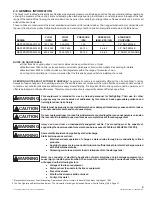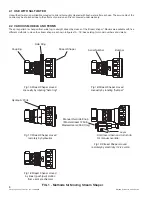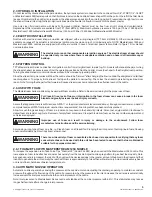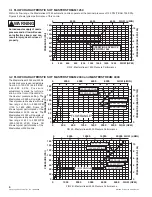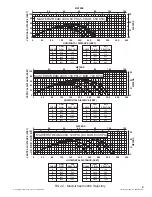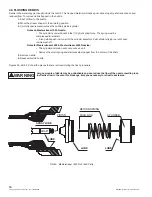
7
3.3 DETERMINING FLOW WITH PRE-PIPED MONITORS
The simplest procedure to determine flow with automatic nozzles is with a flow meter. If a flow meter is unavailable, then the flow may
be estimated using pressure loss data between the nozzle and an in-line pressure gauge at the pump or considerably upstream from
the nozzle. Data is taken with a smooth bore nozzle and handheld pitot gauge. Note: Equations assume no substantial change in
elevation between in-line pressure gauge and nozzle.
Step1: Determine flow of smooth bore nozzle.
F
F
Q
D
P
Flow water with a smooth bore nozzle and record the nozzle's size, pitot pressure and in-line pressure gauge reading. The smooth
bore nozzle's flow is calculated from the Freeman formula:
Where:
= 29.71 for English units (GPM, INCHES, PSI)
= .667 for metric units (LPM, MM, BAR) Note: 1 BAR=100 KPA
flow in GPM (or LPM)
exit diameter in INCHES (or MM)
pitot pressure in PSI (or BAR)
smooth
pitot
Q
= F x D
P
smooth
pitot
2
Q
2
smooth
P
- P
in-line
pitot
C =
©Copyright Task Force Tips, Inc. 1999-2005
Step 2: Find pressure loss constant.
Using the results from step 1, use the following equation to calculate the pressure loss
constant between the in-line pressure gauge and the nozzle:
Where:
piping pressure loss constant in GPM /PSI (or LPM /BAR)
in-line pressure gauge reading in PSI (or BAR)
C
P
2
2
inline
Step 3: Calculate flow with automatic nozzle.
Q
P
Using the pressure loss constant from step 2 and the following equation, the
flow with an automatic nozzle can be calculated for your particular installation.
Where:
automatic nozzle flow in GPM (or LPM)
nominal nozzle operating pressure in PSI (or BAR)
Mount a graph or table of the results adjacent to the in-line pressure gauge.
Deliver any desired flow by adjustment of pump pressure.
auto
auto
Q
=
(P
- P
)C
auto
in-line
auto
0
0
10
10
20
20
30
40
50
60
70
80
0
0
20
10
40
20
60
30
80
40
100
50
120
60
140
70
160
80
90
180
200
220
240
260
280
300
HORIZONTAL DISTANCE (FEET)
VERTICAL
DIST
ANCE
(FEET)
METERS
METERS
A
B
C
D
E
MASTERSTREAM 1250, 100 PSI (7 BAR, 700 KPA )
Figures 4A, 4B and 4C give the stream trajectory for the Masterstream Series nozzles at various flows.
Notes on trajectory graphs:
• Graphs show approximate effective stream trajectory at 30 degrees elevation in no wind conditions. Distance
to last water drops approximately 10% farther.
• Trajectories shown are for water. The addition of foam is expected to decrease the reach by 10%.
• Tail or head winds of 20 MPH (30 KPH) may increase or decrease the range approximately 30%.
• Stream trajectory of Masterstream 4000 based on "The Trajectories of Large Fire Fighting Jets" by A.P. Hatton
and M.J. Osborne, Reference: "The International Journal of Heat and Fluid Flow", Vol 1 No 1.
3.4 STREAM TRAJECTORY DATA
CURVE
A
B
C
D
E
CURVE
A
B
C
D
E
GPM
FLOW
300
400
500
800
1000
LPM
FLOW
1100
1500
1900
3000
3800
LBS
REACTION
150
200
260
400
510
KGF
REACTION
70
90
120
180
230
FIG 4A - Masterstream 1250 Stream Trajectory
LIM-030 October 12, 2005 Rev 05



